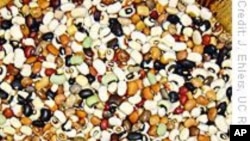Researchers have identified landmarks in the genetic map of the cowpea that may help them breed better varieties more quickly.
The cowpea is an important food and animal feed crop, particularly in drought-prone parts of Asia and Africa.
Jeff Ehlers, a plant breeder at the University of California's Riverside campus, is one of the authors of the new map. He says it gives researchers a set of signposts in the cowpea's genes that will help them find traits such as disease resistance or drought tolerance.
"And this is important because to measure drought tolerance is actually quite time consuming," he says. "So, by having a marker we can assay in the lab, we can do this much more efficiently than going out into the field," Ehlers explains.
Fixing a faulty map
Ehlers says one surprise was that the cowpea genome is a lot smaller than the old map had suggested.
"The old map had a lot of errors in it," he says. "So you can imagine if you're trying to go from Boston to New York and the map isn't right, you'd have some real problems."
Cowpeas are related to soybeans, so discoveries in one plant's genome may help scientists breeding the other.
The research was published in the journal Proceedings of the National Academy of Sciences.
News
Scientists Discover Surprises in New Map of Cowpea Genome
update

<!-- IMAGE -->




